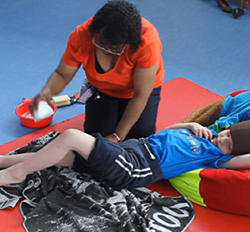Bag Books is a UK registered charity which publishes multi-sensory books to support people with severe or profound and multiple learning disabilities. They are aimed to be enjoyed by people who do not benefit from ‘mainstream’ books by providing stories which are interactive and sensory based rather than relying on words and pictures. They can be enjoyed without being fully understood as they are told using objects, voices, emotions and actions. All of the stories consist of just a few lines, with every line being accompanied by a sensory element, such as something to touch, a sound, a smell, or a physical interaction with the storyteller.
Bag Books use a variety of inexpensive everyday objects and can develop and encourage reactions to stimuli; develop participation in shared activities; develop an interest in people, events or objects; develop focus of attention on people, events or objects; develop acceptance and engagement in co active or shared exploration; develop awareness of activities and experiences; and develop turn-taking skills.
Bag Books have created DIY at home books which can be accessed free of charge and simply require the storyteller to gather the items themselves. The objects are things that you will probably already have or which can be easily and cheaply obtained. Each storyboard also mentions alternatives that could be used for certain elements. The stories are designed to be used at home by a parent/carer in a one-to-one setting and can be found either via the website or using the links below. Each storyboard also contains a link to a film where you can watch an example of the story being told.
Bag Books is a resource which we frequently use in school so will be familiar to your child. The objects needed for the stories are mainly freely accessible everyday items from home however if you are unable to source some of them then please get in touch and we will do our best to get them for you.
If you would like more information then have a look on the website http://www.bagbooks.org/
Bag Books – Don’t Say Egg 2021
Bag Books – Laila in Lockdown 2021
Bag Books – Party in the Sky 2021
Bag Books – The Alien Planet 2021
Bag Books – The Secret Ingredient 2021
Bag Books – Three Little Pigs 2021




































